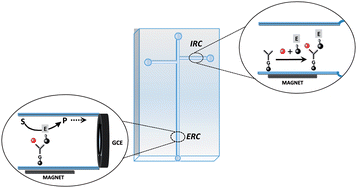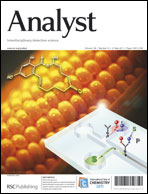Microfluidic technology has now become a novel sensing platform where different analytical steps, biological recognition materials and suitable transducers can be cleverly integrated yielding a new sensor generation. A novel “lab-on-a-chip” strategy integrating an electrokinetic magnetic bead-based electrochemical immunoassay on a microfluidic chip for reliable control of permitted levels of zearalenone in infant foods is proposed. The strategy implies the creative use of the simple channel layout of the double-T microchip to perform sequentially the immunointeraction and enzymatic reaction by applying a program of electric fields suitably connected to the reservoirs for driving the fluidics at different chambers in order to perform the different reactions. Both zones are used with the aid of a magnetic field to avoid in a very simple and elegant way the non-specific adsorption. Immunological reaction is performed under a competitive enzyme-linked immunosorbent assay (ELISA) where the mycotoxin ZEA and an enzyme-labelled derivative compete for the binding sites of the specific monoclonal antibody immobilised onto protein G modified magnetic beads. Horseradish peroxidase (HRP), in the presence of hydrogen peroxide, catalyses the oxidation of hydroquinone (HQ) to benzoquinone (BQN), whose back electrochemical reduction was detected at +0.1 V. Controlled-electrokinetic fluidic handling optimized conditions are addressed for all analytical steps cited above, and allows performing the complete immunoassay for the target ZEA analyte in less than 15 minutes with unique analytical merits: competitive immunoassay currents showed a very well-defined concentration dependence with a good precision as well as a suitable limit of detection of 0.4 µg L−1, well below the legislative requirements, and an extremely low systematic error of 2% from the analysis of a maize certified reference material revealing additionally an excellent accuracy. Also, the reliability of the approach is demonstrated by the analysis of selected infant foods yielding the strictest ZEA permitted levels and excellent recoveries of 103 and 101% for solid and liquid samples, respectively.

You have access to this article
 Please wait while we load your content...
Something went wrong. Try again?
Please wait while we load your content...
Something went wrong. Try again?


 Please wait while we load your content...
Please wait while we load your content...